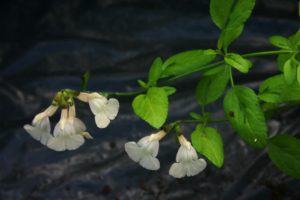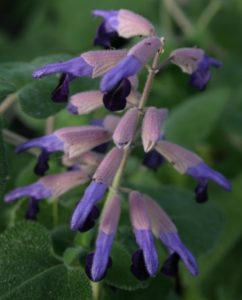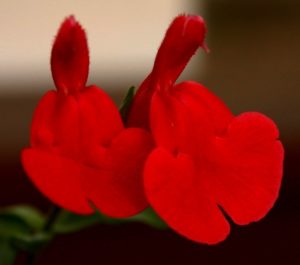Welcome to my new venture:

This year I would like to start a whole new ‘New World Salvia collection’!
First this will be virtual on my blog, but hopefully I will soon be able to grow all these lovely plants into a fantastic collection in reality! I have used this signal red colour as many salvia flowers are of this colour. Like the popular variety above, which has the funny bi-colour! But there are also many blue ones or violet and pink or do we call it maroon or purple (!) and yellow as well as all other colours in between!
They are beautiful: grown for their very vivid colours, mostly flowering en masse, for long periods on end and they are easy to fit into any area of your garden or grown into a container on your patio.
Another less known fact is that the foliage often has a delicious fruity fragrance.
I like to tell you all about them….
My love affair with the Salvias began in the last century; in 1998 to be precise!
This is since I became Head Gardener at Rodbaston College, which is now after amalgamation with 3 other colleges in the County, known as South Staffordshire College, Rodbaston Campus near Stafford in the U.K.
The collection had been started by the former Head Gardener, with the then Head of Horticulture , who both thought it would be a good idea for the College to have a National Collection and they decided it should be the genus Salvia.
But when I started to get to know the genus and in particular the New World ones with all its different species, cultivars and hybrids I slowly built it up to be ‘National Collection of New World Salvias’, which it gained official status in 2002.
Three expeditions to southern Mexico, mainly in the State of Oaxaca and the organisation of a Salvia Study Day at the College got me more and more hooked. I made several very influential friends in the Salvia world to which I still owe my gratitude.
My story below mentions several very influential people in the Salvia world and in particular in Britain. I have copied some information from several books about salvias, as these are often in better words then what I can write myself. You’ll find links for these books, so you can purchase them yourself if you want! They are certainly worth it if you get hooked!

First there was John Massey, who owns Ashwood Nurseries near Kingswinford south of Wolverhampton and has, if you take a look at the link, 110 different varieties for sale at present!
John gave me many of his plants to try out in the collection at the College.
Then one day I got a letter from Robin Middleton, who is now THE Salvia-King of Britain! He has a most wonderful website full of information and a gallery of stunning Salvia pictures and many of those lovely salvias he is also growing in his small suburban garden! Click on his name to get to his website.
Eventually we also met up and he was so generous too, giving me all his surplus plants to enrich the collection with.
The collection grew out to eventually more than 300 varieties, which covered different species from mostly the New World; some species were perfectly hardy, especially being protected inside the old, walled garden.
All these hardy ons I hope to grow in my ‘Salvia Paradise Garden’ one day!
But then there were many tender varieties as well, which was perfectly ok as they adorned first the old and than later the new greenhouses which were built for us in 2005.
But to make a long story short:
I had to give it all up when I left the College in 2009 and now we are nearly a decennia further.
I think it is about time to start a smallish collection again as I have been missing them a lot; although I still have managed to hold on to a few hardy as well as a few tender ones…


